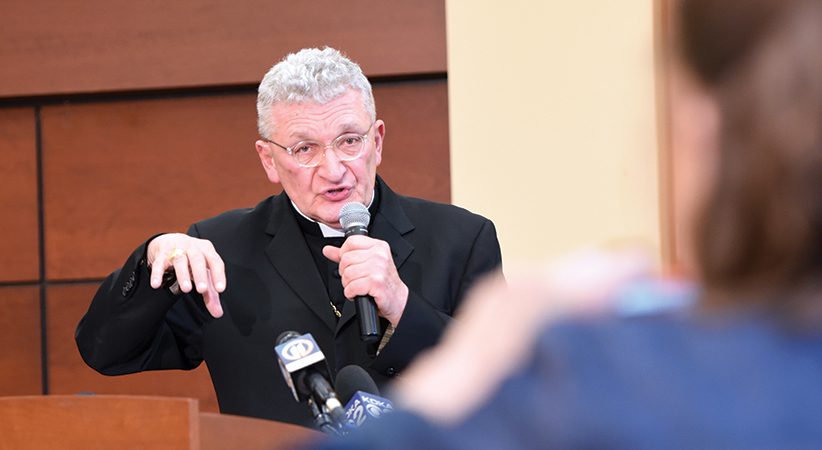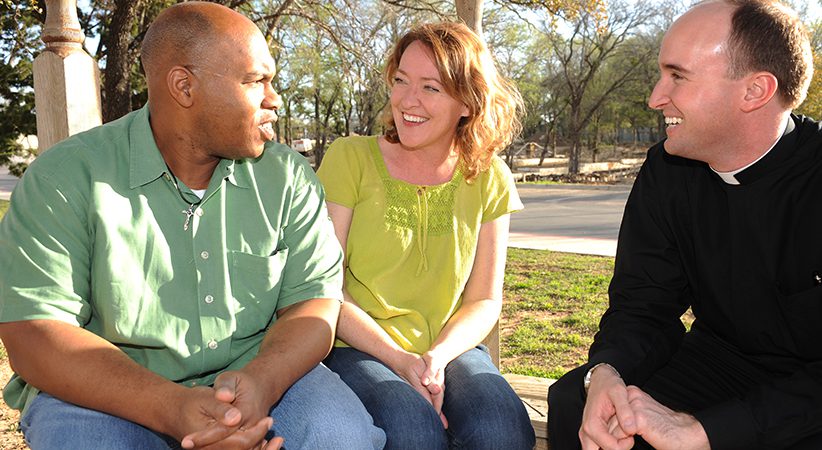How to be Easter Priests
Capturing the joy and sparkle that the season announces
Father Ronald D. Witherup Comments Off on How to be Easter Priests
A seminary faculty colleague of mine had the reputation for being a very fine homilist. He had a knack for exposing the readings of the day in a way that also connected them to daily life. One of his homilies sticks in my mind and always returns to me during the Easter season. He bemoaned in his homily that too many Christians — Catholic seminarians included — did not seem to take the joy of the Easter season seriously.
They walk around with solemn faces, looking severely pious and lost in thought, some virtually with frowns on their faces. He asked: Where is the joy? Why does your face not reflect what you should be feeling internally? Where is that Easter smile, that sparkle of new life that the season announces? I could only think of St. Teresa of Ávila’s famous dictum: “God save us from sullen saints!”
Easter Joy
For all Christians, joy is intimately tied to the resurrection of Jesus and the hope that it has brought to the world. Consequently, we would not exaggerate to call joy the quintessential sentiment of the Easter season. In fact, since every Sunday — the Lord’s day — commemorates the Resurrection, that day also is intimately tied to joy, as the Catechism of the Catholic Church points out (cf. No. 1193).
We are called to rejoice precisely because Jesus Christ conquered sin and death and brought new life into the world to prepare for the eschatological life in the Kingdom. Even in the midst of the Church’s most profound penitential seasons, we recall the Easter joy that is meant to transcend all our other experiences. Thus we celebrate Gaudete Sunday during Advent and Laetare Sunday during Lent. These two different Latin words — from the respective Introits of each Mass — are synonyms in Latin, but the first comes from the Vulgate of Philippians 4:4, while the second is from Isaiah 66:10.
In both instances, joy is not merely a human feeling from the viewpoint of faith. It is a profoundly spiritual attitude that bubbles up from inside one who is filled with the Holy Spirit. Interestingly, St. Paul is the one who points out, when he lists the “fruit” (singular!) of the Spirit, that joy is second on the list, just after love (cf. Gal 5:22). People who love God and neighbor with their whole being can do nothing but be joyous. Easter joy penetrates the depth of human emotions and provides a platform on which to base our response to God’s grace at work in our lives.
So how should priests reflect this Easter joy? Let’s begin with the frank observation about what joy is not. It is not giddiness or an attitude that takes everything lightly. It is decidedly not summed up by a perpetually toothy grin or a saccharine view of the world that too quickly glosses over life’s difficulties. Joy also does not precipitously offer too facile an explanation of a complex or painful subject. Joy does not sweep suffering under a rug and pretend it does not exist. Joy also does not succumb to gloom, pessimism, despair and grumpiness. Joy is actually realistic while, at the same time, offering a vision of a brighter future, which in fact is rooted in our own hope for the resurrection from the dead.
A New Testament Perspective
Joy is clearly rooted in a biblical vision evident in the New Testament, though its roots stretch back into the Old Testament, in which we do not have space here to explore. The two figures most emblematic of joy are Jesus of Nazareth and Paul the Apostle.
One could say that the entire ministry of Jesus was marked with joy. From a Lucan perspective, his very birth brought joy into the world (cf. Lk 2:10-11), and his death on a cross inaugurated already the joy of the Kingdom, which he willingly shared with one of the two crucified with him (Lk 23:43). Many of his parables, most of which touch some aspect of the coming kingdom to which all are invited, speak of the joy that accompanies salvation and forgiveness. It is the joy of finding a lost sheep (15:7), a lost coin (15:9), or a wayward son (15:32). It is the joy of knowing you are loved, despite your sins of commission or omission (19:9).
Joy also paradoxically forms the backdrop of Jesus’ teaching on the necessity of suffering for the sake of the Gospel. He taught in the Sermon on the Mount that joy was to be characteristic of his disciples, even in the face of persecution. At the end of the sermon, in the only (and ninth!) Beatitude presented in the second person plural, Jesus proclaims: “Blessed are you when they insult you and persecute you and utter every kind of evil against you [falsely] because of me. Rejoice and be glad, for your reward will be great in heaven. Thus they persecuted the prophets who were before you” (Mt 5:11-12).
For his part, Paul is virtually the evangelist of joy in the New Testament. Of the 326 occurrences of the vocabulary for joy in the New Testament, some 40% is found in Paul’s letters. No letter is more expressive of joy than Philippians, which is curiously enough one of his “prison epistles.” From prison, he recommends multiple times in this short letter the need for his beloved community to remain joyful, even despite the trials that might come their way because of their faith in Jesus Christ. He exhorts: “Rejoice in the Lord always. I shall say it again: rejoice! Have no anxiety at all, but in everything, by prayer and petition, with thanksgiving, make your requests known to God” (Phil 4:4, 6).
Paul knew that joy was characteristic of Christian identity, and he mirrored it in his own life and called his communities to embrace it.
Pope Francis on Joy

It is remarkable that many teachings from Pope Francis focus on joy. The very titles of some of his most important documents contain words for joy: Evangelii Gaudium, his first solo apostolic exhortation, “The Joy of the Gospel” (2013); Gaudete et Exsultate, the remarkable apostolic letter “Rejoice and Be Glad,” on the universal call to holiness in the modern world (2018); and even Veritatis Gaudium, the apostolic constitution “The Joy of Truth” (2018), on Catholic universities and ecclesiastical faculties. It is impossible to miss the emphasis on joy.
On multiple occasions, the pope has waxed at length about the importance of joy in the Christian life, and especially in the lives of priests. On Aug. 13, 2021, during a video session in Spanish for a group of religious gathered for a virtual continental congress on religious life in Latin America, Francis exhorted them: “Joy, joy in multiple ways. Peace, joy, a sense of humor. Please ask for that grace. In my exhortation on holiness, I wanted precisely to place a chapter on the sense of humor. It is so sad to see consecrated men and women who have no sense of humor, who take everything seriously. Please. To be with Jesus is to be joyful, it is also to have the capacity that gives holiness to this sense of humor” (my translation).
Note here that he draws attention to his apostolic exhortation mentioned above, whose very title evokes the attitude of joy necessary for the Christian life. These sentiments are equally applicable to priests, obviously, and not simply religious. But on another occasion, marking the feast of St. John Vianney, patron of pastors, Francis formally spoke to priests in gratitude for the joy in their lives: “Thank you for the joy with which you have offered your lives, revealing a heart that over the years has refused to become closed and bitter, but has grown daily in love for God and his people. A heart that, like good wine, has not turned sour but become richer with age. ‘For his mercy endures forever’” (Letter to Priests, Aug. 4, 2019).
Joy in the Priesthood
What can we say, then, about joy in the priesthood today? I believe it must be related to five other values that function like “cousins” to joy — namely, remembrance, gratitude, humility, hope, sharing.

Remembrance is a manner of living that is deeply embedded in the biblical tradition. Ancient Israel was always invited to remember the deeds of the Lord, to call to mind in particular the Exodus event and the multiple covenants by which God showed his love for his people. Every Eucharist is an act of remembrance in a similar vein. It is not merely a casual gesture. So each time we celebrate Eucharist, we participate in the long chain of remembrance, which calls for great rejoicing, for singing and praising God, for the magnalia Dei.
Gratitude is essential as well. It is so sad to witness at times the lack of gratitude among clergy. Sometimes it is because they feel slighted — they did not get the plum parish they wanted, or they felt ignored by the bishop or personnel director, or whatever. Gratitude is the ability to be grateful simply because one continues to breathe and live in a world that needs witnesses to God’s love.
Hand in hand with these two attitudes is humility. Humility is linked to joy because it recognizes that each of us is gifted and is ultimately a creature formed by God and endowed with inalienable human dignity, regardless of our status in the world’s categories. Humility is the ability simply to acknowledge who we are, warts and all, knowing that we are not “God’s unique gift to the world.” Humble people do not worry about being disappointed, and thus can foster a joyful attitude even when life seems to be veering off course. Humility is also a recognition that we are not alone but part of a wider community. Each person in the community has something to share; each member has gifts and limitations, which provide a foundation for honest interrelationships.
Most importantly, hope is characteristic of a joyful person. Every priest should be seen as a man of hope. While priests are only human and, of course, can have good days and bad, being an Easter priest means placing the painful or disappointing experiences in perspective. Every Good Friday is followed by an Easter Sunday. Every winter is followed by springtime (at least in the Northern Hemisphere!). Every Christian’s hope is based ultimately on the Resurrection. Jesus died and rose and promised us a share in that same new life. At each Eucharist, when we proclaim the post-consecration acclamation, we acknowledge our stance in hope: Christ has died, Christ is risen, Christ will come again! Hope is forward-looking but is also based on the remembrance of a past event — the Christ event — that continues in the present.
Finally, I would note that Paul connects joy with sharing. Like the gift of love, joy is best when shared with others. Paul even speaks literally of shared joy, employing a unique Greek word (cf. 1 Cor 12:26; Phil 2:17-18).
What, then, is an Easter priest? Certainly not a curmudgeon or a sourpuss, nor a naive, shallow purveyor of false hope. An Easter priest is a man whose inner joy affects the way he comes across to everyone he meets.
How do priests sustain joy in a world filled with so many different counter-messages that could lead one to despair? The essential practice that sustains true joy in the priesthood is prayer, which is rooted in a personal relationship with Jesus Christ. We cannot hope to embody joy and share it with others if we do not foster this critical relationship, which most beautifully flourishes when we celebrate the Eucharist with dignity. As presiders, we are challenged to foster that joy at each Mass, even when internally we may not feel much like celebrating. Thus we come full circle to the advice of my seminary colleague: Show forth your joy!
SULPICIAN FATHER RONALD D. WITHERUP is Superior General of the Society of Saint Sulpice and author of many books on Scripture and theology, including “Gold Tested in Fire: A New Pentecost for the Catholic Priesthood” (Liturgical, 2012) and “Scripture and Tradition in the Letters of Paul” (Paulist, 2021).
………………………………………………………………………………………………………………………………………………………….
St. Paul on Sharing Joy
Paul begins the second chapter of Philippians with a plea for unity and humility, but emphasizing joy: “If there is any encouragement in Christ, any solace in love, any participation in the Spirit, any compassion and mercy, complete my joy by being of the same mind, with the same love, united in heart, thinking one thing” (vv. 1-2).
He then continues to stress joy when speaking of obedience and service in the world: “Do everything without grumbling or questioning, that you may be blameless and innocent, children of God without blemish in the midst of a crooked and perverse generation, among whom you shine like lights in the world, as you hold on to the word of life, so that my boast for the day of Christ may be that I did not run in vain or labor in vain. But, even if I am poured out as a libation upon the sacrificial service of your faith, I rejoice and share my joy with all of you. In the same way you also should rejoice and share your joy with me” (vv. 14-18).
………………………………………………………………………………………………………………………………………………………….





